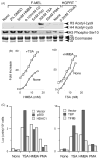Relationship between the induction of leukemia cell differentiation and the enhancement of reporter gene expression in 3T3 Swiss cells
- PMID: 17617452
- PMCID: PMC2778346
- DOI: 10.1016/j.leukres.2007.05.011
Relationship between the induction of leukemia cell differentiation and the enhancement of reporter gene expression in 3T3 Swiss cells
Abstract
The histone deacetylase (HDAC) inhibitor trichostatin A (TSA) and hexamethylene bisacetamide (HMBA), which lacks HDAC inhibitory activity, both possess the capacity to induce leukemia cell differentiation and to enhance the expression of a wide range of transiently transfected reporter genes in 3T3 Swiss cells. In addition, known inducers of leukemia cell differentiation, including hypoxanthine, diazepam, 6-thioguanine and phorbol 12-myristate 13-acetate, also exhibited the ability to enhance reporter gene expression, while randomly chosen compounds that did not induce leukemia cell differentiation did not enhance reporter gene expression. The activity of TSA in the transfection system was modified by co-expression of histone acetyltransferase p300 and HDAC1; whereas, that of HMBA was enhanced by co-expression of the TATA-binding protein TBP. The stimulatory effects of diverse chemical inducers on transiently transfected genes suggest the existence of multiple exploitable targets for the selection of novel inducers of differentiation that function as modulators of gene activity.
Figures




Comment in
-
Multiple exploitable molecular targets for differentiation therapy of leukemias.Leuk Res. 2008 Jan;32(1):1-2. doi: 10.1016/j.leukres.2007.05.018. Epub 2007 Jul 16. Leuk Res. 2008. PMID: 17629556 No abstract available.
Similar articles
-
Activation of transiently transfected reporter genes in 3T3 Swiss cells by the inducers of differentiation/apoptosis--dimethylsulfoxide, hexamethylene bisacetamide and trichostatin A.Eur J Biochem. 2004 Jun;271(12):2379-90. doi: 10.1111/j.1432-1033.2004.04157.x. Eur J Biochem. 2004. PMID: 15182353
-
Protein kinase calpha is an effector of hexamethylene bisacetamide-induced differentiation of Friend erythroleukemia cells.Exp Cell Res. 1999 Feb 1;246(2):348-54. doi: 10.1006/excr.1998.4312. Exp Cell Res. 1999. PMID: 9925750
-
A class of hybrid polar inducers of transformed cell differentiation inhibits histone deacetylases.Proc Natl Acad Sci U S A. 1998 Mar 17;95(6):3003-7. doi: 10.1073/pnas.95.6.3003. Proc Natl Acad Sci U S A. 1998. PMID: 9501205 Free PMC article.
-
Hexamethylene bisacetamide-induced differentiation of transformed cells: molecular and cellular effects and therapeutic application.Int J Cell Cloning. 1988 Jul;6(4):230-40. doi: 10.1002/stem.5530060402. Int J Cell Cloning. 1988. PMID: 3047266 Review.
-
Cell cycle regulatory proteins are targets for induced differentiation of transformed cells: Molecular and clinical studies employing hybrid polar compounds.Int J Hematol. 1996 Jan;63(1):1-17. doi: 10.1016/0925-5710(95)00428-9. Int J Hematol. 1996. PMID: 8713572 Review.
References
-
- Reiss M, Gamba-Vitalo C, Sartorelli AC. Induction of tumor cell differentiation as a therapeutic approach: preclinical models for hematopoietic and solid neoplasms. Cancer Treat Rep. 1986;70:201–18. - PubMed
-
- Huang ME, Ye YC, Chen SR, Chai JR, Lu JX, Zhoa L, et al. Use of all-trans retinoic acid in the treatment of acute promyelocytic leukemia. Blood. 1988;72:567–72. - PubMed
-
- Warrell RP, Jr, de The H, Wang ZY, Degos L. Acute promyelocytic leukemia. N Engl J Med. 1993;329:177–89. - PubMed
-
- Marks PA, Richon VM, Rifkind RA. Histone deacetylase inhibitors: inducers of differentiation or apoptosis of transformed cells. J Natl Cancer Inst. 2000;92:1210–6. - PubMed
Publication types
MeSH terms
Grants and funding
LinkOut - more resources
Full Text Sources
Medical
Research Materials
Miscellaneous

